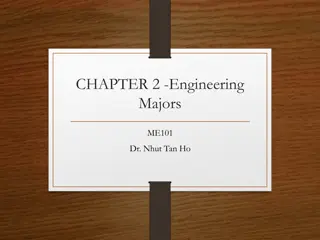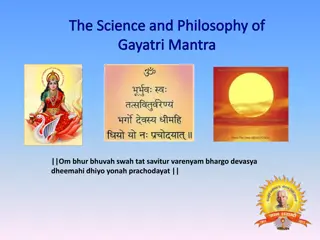Bineswar Brahma Engineering College
This content explores Electromagnetic Field Theory, discussing concepts like fields, static electric and magnetic fields, differences between Circuit Theory and Field Theory, applications, and scalar quantities. It delves into the fundamental principles and applications of electromagnetic fields in various engineering domains.
Download Presentation

Please find below an Image/Link to download the presentation.
The content on the website is provided AS IS for your information and personal use only. It may not be sold, licensed, or shared on other websites without obtaining consent from the author.If you encounter any issues during the download, it is possible that the publisher has removed the file from their server.
You are allowed to download the files provided on this website for personal or commercial use, subject to the condition that they are used lawfully. All files are the property of their respective owners.
The content on the website is provided AS IS for your information and personal use only. It may not be sold, licensed, or shared on other websites without obtaining consent from the author.
E N D
Presentation Transcript
1 Bineswar Brahma Engineering College subject: Electromagnetic field theory Department Of Electrical Engineering 6thSemester 3/9/2025
2 3/9/2025
3 What is field ? Field is a function that specifies a particular quantity everywhere in a region. ELECTROMAGNETIC FIELD This electromagnetic field is produced by interaction of time varying electric and magnetic field. Voltage produces electric field. Time varying electric field produces magnetic field Magnetic field may be stationary or time varying it depends on time varying current. When the current is varying with respect to time then the magnetic field will also vary with respect to time. Time varying magnetic field produces electric field. Ex- transformer (flux varying with respect to time produces emf) 3/9/2025
4 Difference between Circuit Theory and Field Theory Circuit Theory Field Theory Deals with Voltage and Current Deals with the Electric field and magnetic field V & I are scalar E and H are Vector quantity Radiation and effect are neglected Radiation effect is considered Its useful only in low frequency Independent of frequency 3/9/2025
5 Static electric field Static electric fields are constant fields, which do not change in intensity or direction over time, in contrast to low and high frequency alternating fields. Static Magnetic field: A static magnetic field is created by a magnet or charges that move as a steady flow (as in appliances using direct current). Which is also called magnetostatics. Electromagnetic field, a property of space caused by the motion of an electric charge. A stationary charge will produce only an electric field in the surrounding space. If the charge is moving, a magnetic field is also produced. An electric field can be produced also by a changing magnetic field. The mutual interaction of electric and magnetic fields produces an electromagnetic field. 3/9/2025
6 APPLICATIONS Microwave Analysis of Antennas Electric machine, transformers Analysis of power system Electromechanical Energy Conversion Wireless communication Engineering Optical fiber 3/9/2025
7 Scalar Quantity Scalar quantity is defined as the physical quantity with magnitude and no direction. Some physical quantities can be described just by their numerical value (with their respective units) without directions (they don t have any direction). Examples of Scalar Quantities Mass Speed Distance Time Area Volume Density Temperature 3/9/2025
8 Vector Analysis Vector are those quantities which can be represented by magnitude and Direction both. Types of Vectors Zero Vector Unit Vector Position Vector Co-initial Vector Like and Unlike Vectors Co-planar Vector Collinear Vector Equal Vector Displacement Vector Negative of a Vector 3/9/2025
9 Examples of Vector Quantities Linear momentum Acceleration Displacement Momentum Angular velocity Force Electric field Polarization 3/9/2025
10 Unit vector A vector which has a magnitude of unit length is called a unit vector. Suppose if ? is a vector having a magnitude x then the unit vector is denoted by x in the direction of the vector ? and has the magnitude equal to 1 . Its used to indicate the direction of vector quantity. 1.a = (x, y, z) using the brackets 2. a = xi^ + y j^ +z k^ 3/9/2025
11 Position Vector If O is taken as reference origin and P is an arbitrary point in space then the vector OP is called as the position vector of the point. Position vector simply denotes the position or location of a point in the three- dimensional Cartesian system with respect to a reference origin. 3/9/2025
12 Properties of vectors : If A, B, C are vectors and m, n are scalars then (1) Addition A + B = B +A Commutative law A + ( B + C) = (A + B) + C Associative law (2) Subtraction A - B = A + (- B) 3/9/2025
13 Vector Properties (3) Multiplication by a scalar m A = A m Commutative law m (n A) = n (m A) Associative law (m + n) A = m A + n A Distributive law m (A + B) = m A + m B Distributive law A Position vector is represented graphically by a directed line segment. A Unit vector is a vector of unit magnitude and directed along that vector . a A is a Unit vector along the direction of A . 3/9/2025
14 3/9/2025
15 3/9/2025
16 Coordinate system For an explicit representation of a vector quantity, a co-ordinate system is essential. 3/9/2025
17 3/9/2025
18 3/9/2025
19 3/9/2025























